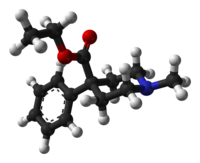페티딘

| |

| |
| 체계적 명칭 (IUPAC 명명법) | |
|---|---|
| Ethyl 1-methyl-4-phenylpiperidine-4-carboxylate | |
| 식별 정보 | |
| CAS 등록번호 | 57-42-1 |
| ATC 코드 | N02AB02 |
| PubChem | 4058 |
| 드러그뱅크 | DB00454 |
| ChemSpider | 3918 |
| 화학적 성질 | |
| 화학식 | C15H21NO2 |
| 분자량 | 247.33g/mol |
| SMILES | eMolecules & PubChem |
| 약동학 정보 | |
| 생체적합성 | 50–60% (Oral), 80–90% (Oral, in cases of hepatic impairment) |
| 단백질 결합 | 65–75% |
| 동등생물의약품 | ? |
| 약물 대사 | 간 |
| 생물학적 반감기 | 2.5–4 hours, 7–11 hours (liver disease) |
| 배출 | Renal |
| 처방 주의사항 | |
| 임부투여안전성 | C(오스트레일리아) C(미국) |
| 법적 상태 |
|
| 중독 경향 | High |
| 투여 방법 | By mouth, IV, IM, IT,[1] SC, epidural[2] |
페티딘(pethidine) 또는 메페리딘(meperidine), 또 그 브랜드명 Demerol 등은 페닐피페리딘계 합성 오피오이드 진통제이다.[3][4][5][6][7][8] 1939년 독일의 화학자 오토 에이슬렙에 의해 잠재적인 항콜린 작용제로서 합성된 이 물질의 진통제적 속성은 독일 파르벤 이익공동체를 위해 일하던 오토 샤우만에 의해 처음 인지되었다.[9]
페티딘은 중간 정도에서 심각한 정도의 통증을 치료하기 위해 사용되며 알약, 시럽, 근육 주사, 피하 주사, 정맥 주사 방식으로 염산염 형태로 투여된다. 20세기 대부분 들어 페티딘은 수많은 의사가 선택하는 오피오이드였다. 1975년, 의사들 가운데 60%는 급성 통증에 대해, 22%는 극심한 만성 고통에 대해 이 약을 처방했다.[10]
모르핀과 비교해 페티딘은 더 안전한 것으로 간주되었고 중독 위험성이 더 낮으며 항콜린성 영향으로 인해 담석이나 신산통과 관련한 통증을 치료하는데 탁월한 것으로 간주되었다.[5] 나중에 이것들은 모두 미신으로 확인되었는데, 즉 동일한 중독의 위험이 있고 다른 오피오이드에 비해 담석이나 신산통에 대한 이익이 없으며 특히 장시간 사용할 경우 다른 오피오이드보다 독성이 있는 신진대사 노르페티딘이 더 독성이 있다.[5] 노르페티딘 신진대사물질은 세로토닌성 효과가 있는 것으로 확인되었으며 이에 따라 페티딘은 대부분의 오피오이드와 달리 세로토닌 증후군을 유발할 수 있다.[5][6]
약물 동력학[편집]
합성[편집]
페티딘은 2단계 합성으로 생성할 수 있다. 1단계는 피페리딘 링의 형성을 위해 나트륨아미드에 존재하는 시안화벤질과 클로메틴의 반응이다. 그 다음 니트릴이 에스터로 변환된다.[11]
각주[편집]
- ↑ Ngan Kee, WD (April 1998). “Intrathecal pethidine: pharmacology and clinical applications.”. 《Anaesthesia and Intensive Care》 26 (2): 137–46. doi:10.1177/0310057X9802600202. PMID 9564390.
- ↑ Ngan Kee, WD (June 1998). “Epidural pethidine: pharmacology and clinical experience.”. 《Anaesthesia and Intensive Care》 26 (3): 247–55. doi:10.1177/0310057X9802600303. PMID 9619217.
- ↑ “Demerol, Pethidine (meperidine) dosing, indications, interactions, adverse effects, and more”. 《Medscape Reference》. WebMD. 2014년 4월 9일에 확인함.
- ↑ Shipton, E (March 2006). “Should New Zealand continue signing up to the Pethidine Protocol?” (PDF). 《The New Zealand Medical Journal》 119 (1230): U1875. PMID 16532042. 2014년 4월 8일에 원본 문서 (PDF)에서 보존된 문서.
- ↑ 가 나 다 라 Latta, KS; Ginsberg, B; Barkin, RL (January–February 2002). “Meperidine: a critical review.”. 《en:American Journal of Therapeutics》 9 (1): 53–68. doi:10.1097/00045391-200201000-00010. PMID 11782820.
- ↑ 가 나 MacPherson RD, Duguid MD (2008). “Strategy to Eliminate Pethidine Use in Hospitals” (PDF). 《Journal of Pharmacy Practice and Research》 38 (2): 88–89. doi:10.1002/j.2055-2335.2008.tb00807.x. 2014년 2월 15일에 원본 문서 (PDF)에서 보존된 문서.
- ↑ Mather, LE; Meffin, PJ (September–October 1978). “Clinical pharmacokinetics of pethidine.”. 《Clinical Pharmacokinetics》 3 (5): 352–68. doi:10.2165/00003088-197803050-00002. PMID 359212.
- ↑ Rossi, S, 편집. (2013). 《Australian Medicines Handbook》 2013판. Adelaide: The Australian Medicines Handbook Unit Trust. ISBN 978-0-9805790-9-3.
- ↑ Michaelis, Martin; Schölkens, Bernward; Rudolphi, Karl (April 2007). “An anthology from Naunyn-Schmiedeberg's Archives of Pharmacology”. 《Naunyn-Schmiedeberg's Archives of Pharmacology》 375 (2): 81–84. doi:10.1007/s00210-007-0136-z. PMID 17310263.
- ↑ Kaiko, Robert F.; Kathleen M. Foley; Patricia Y. Grabinski; George Heidrich; Ada G. Rogers; Charles E. Inturrisi; Marcus M. Reidenberg (February 1983). “Central Nervous System Excitatory Effects of Meperidine in Cancer Patients”. 《Annals of Neurology》 13 (2): 180–185. doi:10.1002/ana.410130213. PMID 6187275.
- ↑ Patent Appl. DE 679 281 IG Farben 1937.


